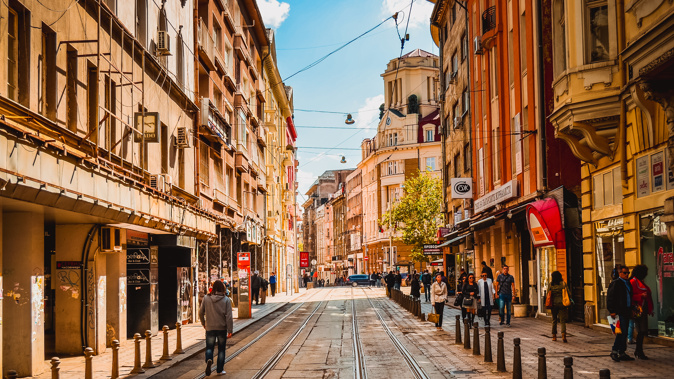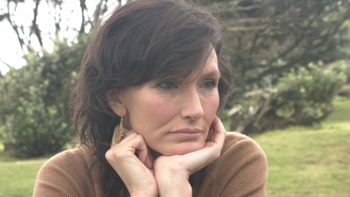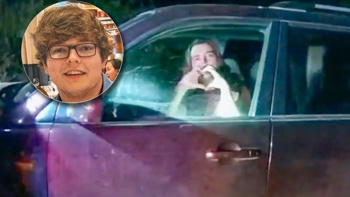
As I struck out on the streets of Sofia, it soon became obvious that Bulgaria’s capital is stacked like a pancake, sitting on layer upon layer of history. Because of its strategic position just north of Greece and Turkey, Bulgaria has seen it all. From ancient Greeks and imperial Romans to fearsome Slavic warriors and the Ottoman Turks, every invader has left their calling card. As did the Cold War communists. Peeling back the layers of this intriguing onion is best done on foot, which is how our group rolled during our city stop in Sofia, on an enthralling two-week long Balkan Adventure with Trafalgar Tours. Sofia is not just Slavic, but distinctly cosmopolitan, with Turks, Arabs, Syrians and Africans enriching it’s demographic make-up. Churches, mosques and synagogues sit side by side.
The Sofia synagogue is one of Europe's largest. As an ally of Germany during most of World War II, Bulgaria was one of the only countries in Nazi territory that refused to hands its Jewish population over to Hitler. No Bulgarian Jews were deported to concentration camps. In a city of curiosities, Sofia even has an actual yellow brick road. The yellowish bricks were a present from Austria's Emperor Franz Josef who after enduring a muddy visit, gifted the bricks to encourage Sofia to pave its streets. Those bricks lead to some important churches.
None more so than Alexander Nevsky Cathedral — one of the largest Orthodox churches in the world, apparently able to hold 10000 worshippers. Named in honour of the Russian military hero who repelled the invading Swedes, Russian architects designed the church with a mix of Russian and Neo-Byzantine styles. Its cascading gold and copper domes are striking from every angle. Inside, I was immersed in the glow of Orthodox tradition.
 Photo / Supplied
Photo / Supplied
Walls glint with gold and silver icons, all from the early 20th century. Bulgaria’s most emblematic landmark commemorates the two million Russian soldiers who died for Bulgaria’s independence during their war against the Ottoman Turks in the late 19th century. If you want to take photos of its lavish interior, be sure to pay to play. Otherwise, you’ll run the risk of falling foul of the steely-eyed scrum of feisty old women who monitor the snap-happy visitors. Like Bulgarian babushkas, they will vigorously bail you up if you haven’t paid for your pixel-burn.
There’s the stunningly sweet antique, the Church of St. George which dates back to the fourth century. This red brick rotunda was originally built as Roman baths, later converted into a church. It’s just by The President’s offices. Then there is St. Sophia Church, dating from the 6th century, which gave the city its name. This terracotta-hued brick basilica, impresses us with its restrained ornamentation. All manner of sporadic discoveries pop up in Sofia. Several years ago, a cluster of fourth-century tombs was unearthed beneath the church. Recently, excavations in the city centre for the metro line’s expansion unearthed magnificent remains of the Roman forum, from building foundations to the public toilets. You can now see the outline of eight Roman streets, baths, houses, and a basilica.
 Photo / Mike Yardley
Photo / Mike Yardley
A priceless find was a Greek earthen jar, brimming with nearly 3000 silver and bronze Roman coins, dating back to the second century. Remnants of the ancient Roman city of Serdica have now been preserved and are on public display, flanked by boardwalks, around the Serdica Metro Station. The city's infrastructure is now being built around its archaeological treasures, rather than bulldozed.
History’s turbulent twists and turns lingers in the air of this great city. Sofia stills wrestles with its communist baggage. Although that chapter of state control is long gone, the architectural legacy still looms large. At Sofia's main intersection, today's parliament offices fill the fearsome Stalinist-style building that was previously the Communist Party headquarters. My guide remarked there are still regular debates about what to do with crumbling communist-era monuments.
Many have already been dispatched to the Museum of Socialist Art, stuffed with a quirky collection of statues, paintings and propaganda movies. In the museum's sculpture garden, the towering statue of Lenin, who once topped the main pillar in the heart of town, still arouses debate. Amid the constellation of museums and art galleries another great stop is the National Museum of History, where glass cases overflow with Thracian gold and Roman artefacts.
You may be surprised to know that Sofia is one of Europe’s greenest capitals. Lush parks speckle Sofia’s city centre like soft, leafy confetti. Ablaze with a riot of flowers, noble trees, and gigantic bronze statues, they are soothing pockets for some quiet contemplation, or for watching the old chaps play chess. Zapaden Park, Severen Park, Zaimov Park, Doctor’s Garden, Kristal Garden, and the National Theatre Garden criss-cross the city. Located on the outskirts of Sofia, Vitosha Mountain towers over the city. Its massive dome rises 2,290 metres high, making it a most accessible ski destination in the winter months. It’s like Europe’s answer to Vancouver’s Grouse Mountain.
 Photo / Mike Yardley
Photo / Mike Yardley
From the modern to the medieval, the old and the new are seemingly happy bed pals in Sofia. Ancient ruins are woven into the city’s landscape as harmoniously as chic eateries. The Central Mineral Baths, an elegant ochre-hued complex accented with colourful ceramic mosaics, is another blast from the past. Fronted by a park and sparkly fountains, the bathing pools no longer operate, but I joined the locals and refilled my water bottle from the free mineral spring water that gushes from the site’s taps.
Zhenski Pazar is Sofia’s famed market —a colourful but chaotic bazaar, throbbing with enticements and energy. In a nod to Sofia’s inclusive ethos, it has shopkeepers from over 40 nations, accentuating its melting-pot ethos. Authentic Arabic items (including Halal meat) jostle for space next to Iraqi bakeries, Kurdish restaurants, Bulgarian pottery and a Syrian grocery. Food shops brim with jars of the famed Bulgarian yoghurt, thick and creamy, with a mildly sour-taste. The locals call it sour milk, Kiselo Mlyako.
 Photo / Supplied
Photo / Supplied
The Blueberry yoghurt is particularly good. This wonderful probiotic food has impeccable ancestry – it’s believed that Bulgarian yoghurt reaches back 4000 years to the Greek influence on Bulgaria. Signature eats in Sofia? Tuck into Mish-Mash, a Bulgarian salad made with fresh cut vegetables, eggs, and sirene cheese, a brined cheese similar to feta. Banitsa is a much-loved traditional Bulgarian pastry. It’s prepared by layering sheets of buttered filo pastry and adding eggs, along with fillings like apple and sirene cheese. And definitely dive into Supa Topcheta, meatball soup. This is a blend of pork meatballs with an array of vegetables, thickened with egg yolks and yoghurt.
If you’re up for a few rounds of rocket-fuel, make tracks to Raketa Rakia bar. This trendy & funky bar, set in a Soviet-era building, feels like a museum and bar in one, with its Soviet-style interior and memorabilia. It hosts an extensive selection of Rakija and great bites. In Bulgaria, plum and grape rakia is often mixed with various herbs, honey and sour cherries. Boom! Sofia’s dazzling night-life scene is underpinned by their joy of “chalga”, Bulgaria’s eclectic blend of folk and pop music, combining live dance tunes with oriental and gypsy motifs – not dissimilar to Serbia’s love-affair with turbo folk. Rock’N’Rolla Club and the Bedroom are two top spots.
 Photo / Supplied
Photo / Supplied
Trafalgar’s amazing Balkan Adventure is a 14 day tour, spanning seven countries and 13 cities. Enjoy excellent four-star accommodations, extensive sightseeing, outstanding specialist local guides, super-comfy coach travel with on-board Wi-Fi, plus most meals are included. It’s a hassle-free way to explore this eye-opening part of the world. For 2024 tour dates, prices start from $5,895 per person, twin share. www.trafalgar.com/en-nz/tours/balkan-adventure
Planning to explore Europe by train? Grab a ticket to ride on the European railway network with a Eurail Pass. On popular rail routes, it certainly pays to make a seat reservation in advance. Lock in your rail plans ahead of your trip, by booking tickets or a rail pass to suit with Eurail direct. The mobile pass is the fuss-free way to go, without having to worry about losing paper tickets. The Eurail app is easy to navigate, packed with helpful information and benefits, network disruption notifications, and enabling you to check timetables, lock in bookings and seat reservations on the go, via your mobile. www.eurail.com
I jetted my way to Europe with Cathay Pacific Airways, Hong Kong’s award-winning flag-carrier. Connecting Kiwis to Hong Kong and beyond for 40 years, Cathay Pacific’s Auckland services will be complemented with the resumption of seasonal summer services between Christchurch and Kong Kong, from December. Cathay Pacific services an excellent range of European ports, including Milan, Amsterdam, Paris, Madrid, Zurich, Frankfurt, London and Manchester.
Treat yourself to extra-comfort with Premium Economy. You’ll enjoy a generous seat recline, expanded legroom and a supported head rest. Full-length calf rests and leather-padded footrests accentuate the comfort. An award-winning selection of wines and beverages are on-hand to accompany your meal. Enjoy larger pillows, softer blankets and an amenity kit, to welcome drinks, complimentary water bottle and an enticing array of entrees and snacks. In Premium Economy, you’ll score double the checked baggage allowance – 2 pieces of up to 23kg per bag.
Premium Economy and Economy passengers have seating configurations equipped with dedicated tablet holders so you can mount your own devices, exclusive power outlets and USB ports. Across all classes, I was particularly impressed by the on-demand entertainment. Post-pandemic, the curated line-up of content has been super-sized by four times the previous offering, with over 3000 hours of film, TV and music content, at your fingertips – and it’s refreshed monthly. www.cathaypacific.com/nz
Mike Yardley is our resident traveller on Jack Tame Saturday Mornings.
Take your Radio, Podcasts and Music with you









